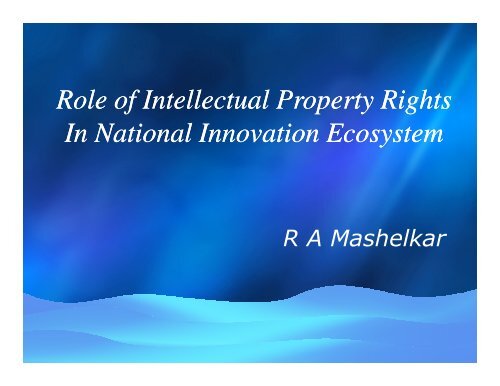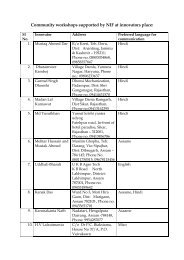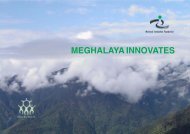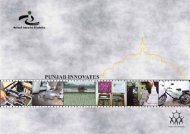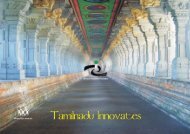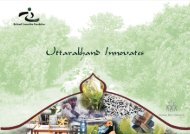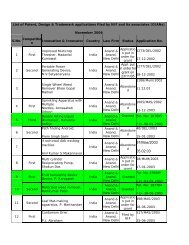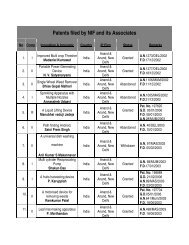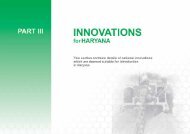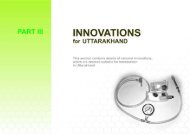Role of Intellectual Property Rights In National Innovation Ecosystem
Role of Intellectual Property Rights In National Innovation Ecosystem
Role of Intellectual Property Rights In National Innovation Ecosystem
You also want an ePaper? Increase the reach of your titles
YUMPU automatically turns print PDFs into web optimized ePapers that Google loves.
<strong>Role</strong> <strong>of</strong> <strong><strong>In</strong>tellectual</strong> <strong>Property</strong> <strong>Rights</strong><br />
<strong>In</strong> <strong>National</strong> <strong>In</strong>novation <strong>Ecosystem</strong><br />
R A Mashelkar
Top Patenting US Universities - 2007<br />
University<br />
Patent Granted<br />
2007<br />
University <strong>of</strong> California 333<br />
Mass. <strong>In</strong>stitute <strong>of</strong> Technology 141<br />
California <strong>In</strong>stitute <strong>of</strong> Technology 116<br />
University <strong>of</strong> Wisconsin 91<br />
University <strong>of</strong> Texas 90<br />
Stanford University 85<br />
University <strong>of</strong> Central Florida 57<br />
Columbia University 55<br />
Cornell University 54
George Whitesides<br />
•Highest cited scientist in the world<br />
•Market capitalization <strong>of</strong> companies floated<br />
from his Harvard Univ Based research is $ 20 bn
Act allows transfer <strong>of</strong> exclusive control over government<br />
funded inventions to universities and businesses<br />
operating with federal contracts for commercialization.<br />
Contracting universities and businesses are permitted to<br />
exclusively license the inventions to other parties.<br />
Federal government retains "March-in" rights to license<br />
the invention to a third party, where it determines that<br />
invention is not being made available to the public on a<br />
reasonable basis.
Pre-1980, University share <strong>of</strong> patents only<br />
0.03%<br />
10 folds increase in patents in last 15 years<br />
Universities filing ~ 4000 patent applications<br />
annually<br />
Also issuing ~ 3500 licenses & options annually
Recombinant DNA technology, central to the<br />
biotechnology industry, Stanford University and University<br />
<strong>of</strong> California<br />
Cisplatin and caboplatin cancer therapeutics, Michigan<br />
State University<br />
Metal Alkoxide process for taxol production, Florida State<br />
University<br />
Artificial lung surfactant for use with newborn infants,<br />
University <strong>of</strong> California<br />
Haemophilus B conjugate vaccine, University <strong>of</strong><br />
Rochester<br />
Process for inserting DNA into eucaryotic cells and for<br />
producing proteinaceous materials, Columbia University<br />
TRUSOPT (dorzolamide) ophthalmic drop used for<br />
glaucoma, University <strong>of</strong> Florida<br />
And others……
Stanford University: 1950 vs. Today<br />
<strong>National</strong> Medal<br />
<strong>of</strong> Science<br />
0 30<br />
Nobel Prize 0 28<br />
Winners<br />
Annual Budget $100M $3.2B<br />
Sponsored<br />
Research<br />
$11M $1.06B
A University Can Be A Wellspring Of<br />
<strong>In</strong>novation<br />
• Stanford graduates, faculty and staff have<br />
launched approximately 1200 companies in<br />
the last 50 years<br />
• More than 50% <strong>of</strong> Silicon Valley product is due<br />
to companies started by Stanford alumni
Stanford Strategy<br />
Encourage graduating students and faculty to start<br />
companies (Over 1200 companies to date accounting for<br />
over 50% <strong>of</strong> Silicon Valley output)<br />
Create <strong>In</strong>dustrial Park with inexpensive land leases (now<br />
over 150 companies in the “Research” Park)<br />
Offer cutting-edge education to company employees<br />
(Engineering Honors Cooperative Program; now reaches<br />
hundreds <strong>of</strong> companies over the internet)<br />
Assist in development <strong>of</strong> Venture Capital <strong>In</strong>dustry<br />
Form <strong>In</strong>dustrial Affiliates Programs (now over 40)
Waves <strong>of</strong> <strong>In</strong>novation in Silicon Valley History
Amazing Numbers!<br />
$1,426 Million in Royalties<br />
$54 Billion in Licensed Products Sales<br />
435,000 new Jobs<br />
18,178 new <strong>In</strong>vention Disclosures<br />
11,089 new Patent filings<br />
5,327 new Licenses (10% to Start-Up<br />
Companies)
Patents Filed<br />
12000<br />
10000<br />
8000<br />
6000<br />
4000<br />
Patents Filed<br />
2000<br />
0<br />
1991 1993 1995 1997 1999 2001 2003
<strong>In</strong>spiring Stories<br />
• Stanford<br />
• MIT<br />
• Cambridge<br />
• Oxford<br />
• Others following in Europe & Asia Pacific
How to Bridge the gap<br />
23<br />
Academic<br />
Research<br />
Catalyst<br />
Program<br />
Events<br />
Commercial<br />
Enterprise<br />
Grant<br />
Program<br />
<strong>In</strong>novation-<br />
Teams
MIT ECOSYSTEM<br />
TECHLINK<br />
INNOVATION<br />
CLUB<br />
I-TEAMS<br />
SEBC<br />
VCPE<br />
ENTREPENEURSHIP<br />
CENTER<br />
$100K<br />
COMPETITION<br />
MIT SLOAN<br />
24<br />
DESHPANDE<br />
CENTER<br />
MIT VMS<br />
MIT TLO<br />
MIT<br />
ENTERPRISE<br />
FORUM<br />
COMMERCIALIZATION
Greater Boston Area<br />
HARVARD<br />
BOSTON COLLEGE<br />
BOSTON UNIVERSITY<br />
BRANDEIS UNIVERSITY<br />
MASSACHUSETTS INSTITUTE OF TECHNOLOGY<br />
NORTHEASTERN UNIVERSITY<br />
TUFTS UNIVERSITY<br />
UNIVERSITY OF MASSACHUSETTS @BOSTON<br />
University innovation led wealth and jobs<br />
• $7.4 billion boost to the regional economy<br />
• 48,750 new University jobs<br />
• 37,000 new other jobs for workers in the region<br />
• continuing education for 25,000 non-degree students
University (Conventional)<br />
Generation <strong>of</strong> new Knowledge<br />
Enterprise<br />
Creation <strong>of</strong> Wealth & Jobs<br />
University (new)<br />
(Public Good)<br />
(Private Good)<br />
Balancing new knowledge generation &<br />
wealth creation<br />
(Public & Private Good)
The Cambridge Phenomenon<br />
Then:<br />
-University largely ignored IP issue<br />
-Adopted a liberal attitude to what academics did<br />
- <strong>In</strong>dustrial liaison merely acted as ‘window’<br />
on what university did- little exchange or dialogue
Cambridge Now
Principal Components that Caused and Shaped Cambridge Phenomenon after<br />
1960s<br />
Seiko Epson<br />
Research<br />
Lab<br />
Analysys<br />
Toshiba<br />
Cambridge<br />
Research<br />
Laboratory<br />
Cambridge<br />
<strong>In</strong>teractive<br />
System<br />
Olivetti Research<br />
Laboratory<br />
(acquired by<br />
AT&T in 1999)<br />
MRC<br />
Laboratory<br />
<strong>of</strong> Molecular<br />
Biology<br />
Cambridge<br />
Science Park<br />
Judge <strong>In</strong>stitute <strong>of</strong><br />
Management<br />
Studies<br />
CAD<br />
Centre<br />
Acorn<br />
Cambridge<br />
University<br />
1970<br />
1960<br />
CCL<br />
Barclays Bank<br />
PA<br />
Technology<br />
1980<br />
St. John<br />
<strong>In</strong>novation<br />
Centre<br />
Cambridge Research and<br />
<strong>In</strong>novation Ltd (CRIL)<br />
Scientific<br />
Generics<br />
Sinclair<br />
Radionics<br />
The Technology<br />
Partnership<br />
TTP<br />
Eicon<br />
Research<br />
Ltd<br />
Sinclair<br />
Research Ltd<br />
<strong>In</strong>stitute <strong>of</strong><br />
Biotechnolog<br />
y<br />
Cantab<br />
Pharmaceuticals<br />
Glaxo<br />
Nickerson<br />
Biotech<br />
Laboratory<br />
Hitachi<br />
Cambridge<br />
Laboratory<br />
TTP Ventures<br />
Glaxo <strong>In</strong>stitute<br />
<strong>of</strong> Applied<br />
Pharmacology<br />
BP<br />
Unilever Cambridge<br />
Centre for Molecular<br />
<strong>In</strong>formatics<br />
Cambridge<br />
Network<br />
1990<br />
<strong>In</strong>stitute <strong>of</strong><br />
Manufacturing<br />
Entropic Research<br />
Laboratory (acquired<br />
by Micros<strong>of</strong>t in 1999)<br />
Amadeus Capital<br />
Partners<br />
2000
Top Universities & Organizations – PCT Filings 2007<br />
Organization<br />
Electronics and Telecommunications<br />
Research <strong>In</strong>stitute<br />
Agency for Science, Technology & Research<br />
Council <strong>of</strong> Scientific & <strong>In</strong>dustrial Research<br />
Seoul <strong>National</strong> University <strong>In</strong>dustry Foundation<br />
Korea <strong>In</strong>stitute <strong>of</strong> Science & Technology<br />
Hong Kong Applied Science & Technology<br />
Research <strong>In</strong>stitute<br />
Korea Research <strong>In</strong>stitute <strong>of</strong> Bioscience<br />
& Biotechnology<br />
<strong>National</strong> University <strong>of</strong> Singapore<br />
Korea Advanced <strong>In</strong>stitute <strong>of</strong> Science<br />
& Technology<br />
Country<br />
S Korea<br />
Singapore<br />
<strong>In</strong>dia<br />
S Korea<br />
S Korea<br />
China<br />
S Korea<br />
Singapore<br />
S Korea
CSIR’s IP Policy (1996)<br />
Statement <strong>of</strong> the IP Policy<br />
“The maximization <strong>of</strong> the benefits to CSIR from its<br />
intellectual property by stimulating higher levels <strong>of</strong><br />
innovation through a judicious system <strong>of</strong> rewards,<br />
ensuring timely and effective legal protection for its<br />
IP and leveraging and forging strategies alliances for<br />
enhancing the value <strong>of</strong> its IP.”<br />
CSIR Targets (Vision 2001)<br />
Portfolio <strong>of</strong> 500 foreign patents (then 80 in 1996)<br />
Portfolio <strong>of</strong> 1000 <strong>In</strong>dian patents (then 436 in 1996)
STRATEGY TO IMPLEMENT THE POLICY<br />
•Balanced system <strong>of</strong> recognition and rewards;<br />
•structured in-house and external pr<strong>of</strong>essional training programmes;<br />
•assessment <strong>of</strong> techno-legal and business information in related IP<br />
documents;<br />
•establishing and enforcing a formal mechanism <strong>of</strong> recording and<br />
authentication ;<br />
•encourage the publication <strong>of</strong> R&D results in scientific papers only after<br />
careful consideration <strong>of</strong> the consequences on IP rights.<br />
•availing the services <strong>of</strong> high class national and foreign consultants and<br />
attorneys;<br />
•monitoring national & international patents through access to on-line<br />
databases;<br />
•Analysing and assessing techno-legal and business information & market<br />
intelligence to identify strategic alliances;<br />
•Strengthening the IPMD <strong>of</strong> CSIR<br />
•Mobilizing public opinion and influencing government decision/policy on<br />
diverse IP issues through analytical and scientific studies .
160<br />
140<br />
120<br />
100<br />
6 4 4 7 8 10 11 22 38 39 39<br />
80<br />
US patents granted to CSIR<br />
Awareness<br />
Building<br />
Overdrive<br />
149 141 142<br />
111<br />
IP Policy<br />
Lack <strong>of</strong> Awareness<br />
69<br />
1992-93<br />
1993-94<br />
1994-95<br />
1995-96<br />
1996-97<br />
1997-98<br />
1998-99<br />
1999-00<br />
2000-01<br />
2001-02<br />
2002-03<br />
2003-04<br />
2004-05<br />
2005-06<br />
1991-92<br />
1990-91<br />
60<br />
40<br />
20<br />
0<br />
Rationalisation
% share <strong>of</strong> CSIR in the total US patents granted to<br />
<strong>In</strong>dians (excluding foreign assignees)<br />
70.0<br />
60.0<br />
50.0<br />
40.0<br />
30.0<br />
20.0<br />
10.0<br />
0.0<br />
64.3<br />
57.6<br />
62.0<br />
45.9<br />
49.6<br />
33.0<br />
2000-01 2001-02 2002-03 2003-04 2004-05 2005-06
Global Partnerships
NCL patents trigger <strong>In</strong>dia’s emergence as a<br />
global R&D platform<br />
NCL’s patents on polycarbonates<br />
<br />
Licensed to GE in early nineties<br />
“If they are so good, why are we not there ”<br />
– Jack Welch, CEO - GE<br />
GE’s decision to set up Jack Welch R&D<br />
Centre in Bangalore (1995)<br />
Others follow – today 300+ R&D centres set<br />
up by multinationals
NCL patents breaking monopolies<br />
THPE [1,1’,1”-Tris(4’-hydroxyphenyl) ethane]<br />
a branching agent for the synthesis <strong>of</strong> high<br />
grade polycarbonates.<br />
Breaking Hoechst Celanese (US)’s monopoly<br />
through Excel (<strong>In</strong>dia) manufacturing based on<br />
NCL patents.
Doing Business with IP
<strong>In</strong>dian Pharmaceutical <strong>In</strong>dustry<br />
From copying molecules to creating molecules<br />
50s Formulation Mostly imported - MNC Dominance<br />
60s Formulation Based on imported bulk drugs<br />
70s<br />
Formulation<br />
Bulk Drugs<br />
Little Import<br />
<strong>In</strong>digenous manufacture by domestic<br />
companies<br />
80s<br />
Formulation<br />
Marginal imports<br />
Bulk Drugs<br />
Mostly indigenous manufacture based on<br />
domestic R&D<br />
90s<br />
Formulation<br />
Bulk Drugs<br />
<strong>In</strong>significant imports<br />
Net Exporter<br />
2000+ Drugs & Pharma Strong Generics<br />
New Molecule Research
Protecting <strong>Rights</strong> <strong>of</strong> the Poor<br />
UN Commission on Human <strong>Rights</strong><br />
April 2001
Grim Scenario in Health<br />
• 3 million deaths by HIV/AIDS (2.3 million<br />
in sub – Sahara Africa) 1 million deaths by<br />
malaria<br />
• Poorest spend 12% <strong>of</strong> their income on<br />
healthcare as opposed to 2% by rich<br />
• One episode <strong>of</strong> hospitalization wipes <strong>of</strong> all<br />
the assets <strong>of</strong> a poor family
Import <strong>of</strong> medicines by Government<br />
(Section 47)<br />
Acquisition <strong>of</strong> patent right by<br />
Government (Section 102)<br />
Conditional grant <strong>of</strong> patent (Section 47)<br />
Bolar provision ( Section 107A(a)<br />
Research and Experimentation<br />
Exemptions (Section 47)<br />
Revocation <strong>of</strong> Patent in public interest<br />
(Section 66)
Knowledge systems<br />
• Formal<br />
– S&T institutions<br />
– Universities<br />
– <strong>In</strong>dustry<br />
• <strong>In</strong>formal – laboratories <strong>of</strong> life<br />
– Community<br />
– Civilizational<br />
– Parallel<br />
– <strong>In</strong>digenous
Comparison <strong>of</strong> U.S. Patents with references cited in Ayurveda<br />
PRIOR ART<br />
S.N. US PATENT DETAILS REFERENCES CITED<br />
IN AYURVEDA<br />
REMARKS<br />
3 5,725,859 granted on 10 th March 1998<br />
Applicant: Omer Osama L. M.<br />
Application filed on June 3 rd 1996<br />
Title: Plant based therapeutic agent with virustatic and<br />
antiviral effect<br />
Claims: there are four claims. First two claims i.e. 1&2<br />
relate to a method <strong>of</strong> treating a patient infected with DNA<br />
virus <strong>of</strong> the herpes family or DNA hepatitis B or hepatitis C<br />
viruses, or suffering from chronic allergic rhino-sinobronchitis,<br />
by administering to the said patient a<br />
pharmaceutical composition as claimed. Claim 3&4 define a<br />
pharmaceutical composition which comprises at least two <strong>of</strong><br />
the compounds selected from the group consisting <strong>of</strong> 1.<br />
absinthe (artemisia absinthium) 2. Resin <strong>of</strong> mastic (resin<br />
pistacia lenticus) and 3. Fruit <strong>of</strong> delphinium denudatum.<br />
This composition further comprises at least one <strong>of</strong> the<br />
compounds selected from the groups consisting <strong>of</strong> rose<br />
wood (flores rosae), seeds <strong>of</strong> cardamom (fructus ellettaria<br />
cardmomum) and borgae flowers (flores onosma brateatum<br />
boriginaceae).<br />
1. Caraka-samhita,<br />
Ci-101, page 240<br />
Use <strong>of</strong> ellettaria<br />
cardamom in a compound<br />
formulation for treatment<br />
<strong>of</strong> kapha roga.<br />
2. Bhava prakasa<br />
nighantu, page 829<br />
Use <strong>of</strong> delphiniun<br />
denudatum in treatment <strong>of</strong><br />
kapha roga. Chronic<br />
allergic rhino-sino<br />
bronchitis is a form <strong>of</strong><br />
kapha roga.<br />
References<br />
resemble the<br />
treatment<br />
described in<br />
patented<br />
invention.
Changing <strong>In</strong>dian IPR Mindset:<br />
Relentless Battle!<br />
Publish or Perish<br />
To<br />
Patent, Publish and Prosper<br />
1 June, 1989<br />
<strong>National</strong> Chemical Laboratory
Changing <strong>In</strong>dian IPR Mindset:<br />
Relentless Battle!
Changing <strong>In</strong>dian IPR Mindset:<br />
Relentless Battle!
Changing <strong>In</strong>dian IPR Mindset:<br />
Relentless Battle!
Positioning Universities for the 21 st Century<br />
in the Knowledge Space<br />
High<br />
Bohr<br />
Pastuer<br />
Quest for<br />
Fundamental<br />
Understanding<br />
Edison<br />
Low<br />
Application <strong>of</strong> Knowledge<br />
High
<strong>In</strong>dian Academia & IP<br />
Yesterday<br />
“Publish or Perish”<br />
Tomorrow<br />
“Patent, Publish & Prosper”
<strong>In</strong>dian <strong>In</strong>dustry & IP<br />
Yesterday<br />
“Borrower <strong>of</strong> IP”<br />
Tomorrow<br />
“Creator & Licensor <strong>of</strong> IP”
400<br />
IPR - IN PROCESS & GRANTED AT TATA STEEL<br />
350<br />
Cumulative No. <strong>of</strong> Patents<br />
300<br />
250<br />
200<br />
150<br />
100<br />
50<br />
0<br />
63<br />
44<br />
22<br />
274<br />
256<br />
20<br />
174<br />
17<br />
16<br />
106<br />
8 13 16<br />
60<br />
16 19 22<br />
38<br />
Upto 1999 1999-00 2000-01 2001-02 2002-03 2003-04 2004-05 2005-06 2006-07<br />
<strong>In</strong>-Process<br />
Granted
<strong>In</strong>dian <strong>In</strong>dustry<br />
Yesterday<br />
“Pride in being First to <strong>In</strong>dia”<br />
Tomorrow<br />
“Will only Pride in Being First to the<br />
World”
<strong>In</strong>dian IQ Creating IP for Foreign Firms<br />
<strong>In</strong>dian IQ generating IP for foreign companies<br />
City<br />
US Patents<br />
granted for<br />
<strong>In</strong>dian firms<br />
US Patents<br />
granted to<br />
foreign firms<br />
with <strong>In</strong>dian<br />
inventors<br />
Total Patents<br />
%IP Created<br />
For foreign<br />
firms<br />
Bangalore<br />
39 435 474 91.8<br />
Delhi<br />
143 186 329 56.5<br />
Hyderabad<br />
94 40 134 29.9<br />
Mumbai<br />
84 183 267 68.5<br />
Pune<br />
87 94 181 51.9<br />
Lucknow<br />
83 16 99 16.2
The Challenge<br />
• <strong>In</strong>dian mind to <strong>In</strong>dian marketplace<br />
• <strong>In</strong>novation in <strong>In</strong>dia for <strong>In</strong>dia<br />
• <strong>In</strong>dian IQ for <strong>In</strong>dian IP
Nano first to the world<br />
Nano – 36 patents!
THANK YOU


